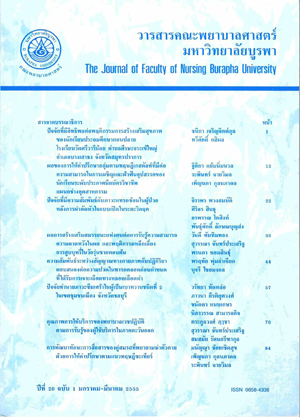ปัจจัยทำนายภาวะซึมเศร้าในผู้เป็นเบาหวานชนิดที่ 2 ในเขตชุมชนเมือง จังหวัดชลบุรี
คำสำคัญ:
ผู้เป็นเบาหวานชนิดที่ 2 ภาวะซึมเศร้า, Type 2 diabetes, depressionบทคัดย่อ
การวิจัยครั้งนี้ศึกษาปัจจัยทำนายภาวะซึมเศร้าในผู้เป็นเบาหวานชนิดที่ 2 ในเขตชุมชนเมืองจังหวัดชลบุรี โดยปัจจัยที่เลือกสรรได้แก่ ระยะเวลาการเป็นเบาหวาน จำนวนโรคร่วม สัมพันธภาพในครอบครัว ความรู้สึกมีคุณค่าในตนเอง และการดูแลตนเอง กลุ่มตัวอย่างเป็นผู้เป็นเบาหวานในเขตชุมชนเมือง มารับบริการ ณ คลินิกโรคเบาหวาน โรงพยาบาลเมืองชลบุรี จำนวน 262 ราย เลือกกลุ่มตัวอย่างโดยการสุ่มอย่างง่าย กลุ่มตัวอย่างตอบแบบสอบถามจำนวน 5 ฉบับ ได้แก่ แบบสอบถามข้อมูลส่วนบุคคล แบบสอบถามสัมพันธภาพในครอบครัว แบบสอบถามความรู้สึกมีคุณค่าในตนเอง แบบสอบถามการดูแลตนเอง และแบบประเมินภาวะซึมเศร้า วิเคราะห์ข้อมูลด้วยสถิติเชิงพรรณนา และสถิติถดถอยพหุคูณ
ผลการวิจัยพบว่า กลุ่มตัวอย่างมีคะแนนเฉลี่ยสัมพันธภาพในครอบครัว และความรู้สึกมีคุณค่าในตนเองอยู่ในระดับปานกลาง คะแนนเฉลี่ยภาวะซึมเศร้าอยู่ในระดับปานกลางถึงมากร้อยละ 39.3 ระยะเวลาการเป็นเบาหวาน จำนวนโรคร่วม สัมพันธภาพในครอบครัว ความรู้สึกมีคุณค่าในตนเอง และการดูแลตนเอง สามารถร่วมกันทำนายภาวะซึมเศร้าในผู้เป็นเบาหวานชนิดที่ 2 ได้ร้อยละ 77 (R2= 77, p < .001) โดยพบว่าสัมพันธภาพในครอบครัวเป็นตัวแปรทำนายภาวะซึมเศร้าในผู้ป่วยเบาหวานชนิดที่ 2 ได้มากที่สุด (β = -.46, p< .001) รองลงมาได้แก่ ความรู้สึกมีคุณค่าในตนเอง (β = -.33, p < .001) การดูแลตนเอง (β = -.23, p <.01) จำนวนโรคร่วม (β = .21, p < .01) และระยะเวลาการเป็นเบาหวาน (β = .13, p < .05) ตามลำดับ
ผลการวิจัยแสดงให้เห็นว่า พยาบาลผู้ให้การดูแลผู้เป็นเบาหวานควรออกแบบการพยาบาลเพื่อส่งเสริมสัมพันธภาพในครอบครัว เพิ่มความรู้สึกมีคุณค่าในตนเอง และการดูแลตนเอง ในผู้เป็นเบาหวานเขตชุมชนเมืองเพื่อป้องกันและลดภาวะซึมเศร้าในผู้เป็นเบาหวานต่อไป
This predictive correlational study aimed to examine predictive factors of depression in persons with type 2 diabetes in urban areas at Chonburi province. Selected predictive factors consisted of duration of diabetes, the number of diabetes co-morbidity, family relationship, self-esteem, and diabetes self-care. Two hundred and sixty two subjects from diabetes outpatient clinic at Maung Chonburi hospital were included in this study by simple random sampling. The subjects completed 5 questionnaires including the Demographic Data, the Family Relationship, the Rosenberg’s Self Esteem Questionnaire, the Diabetes Self Care, and Beck’s Depression Inventory. Data were analyzed using descriptive statistics and multiple regression analysis.
The results showed that the mean score of family relationship and self esteem were at a moderate level. Mean score of depression at a moderate to high level 39.3 percents. Duration of diabetes, the number of diabetes co-morbidity, family relationship, self esteem, and diabetes self care jointly predicted depression in persons with type 2 diabetes (R2= 77, p < .001). The strongest predictor of depression was family relationship (β = -.46, p < .001), followed by self esteem (β = -.33, p < .001), diabetes self-care (β = -.23, p < .01), the number of diabetes co-morbidity (β = .21, p < .01), and duration of diabetes (β = .13, p < .05), respectively.
The findings showed that diabetes nurses should further design nursing interventions to enhance family relationship, self esteem and diabetes self-care for preventing depression in persons with diabetes in urban areas to prevention and decrease depression in persons with diabetes.





